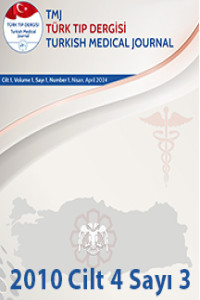Abstract
Systemic sclerosis is a multisystem connective tissue disease, characterized by immunulogic abnormalities besides the skin and internal organ fibrosis. The progress and organ involvement of the disease varies. Pulmonary involvement presenting as parenchymal disease of the lungs or pulmonary hypertension is frequently seen and causes severe morbidity and mortality. Hyperhomocysteinemia, is a independant modifiable risk factor for coronary, cerebral and peripheral vascular diseases. In the presenting study, we evaluated the general findings, lung involvement and plasma homocystein levels of systemic sclerosis patients.
This study included 29 patients attending to Ankara University Faculty of Medicine Department of Clinic Immunology and Rheumatology and 16 healthy control cases. Of 29 patients, 12 patients had limited and 17 patients have diffuse form of the disease. Of 29 patients, 6 patients had no pulmonary involvement, 14 patients had mild to moderate and 9 patients had severe or end-stage pulmonary involvement. There was no significant differences between plasma homocystein and cholesterol and triglyceride levels.
Systemic sclerosis is a multisystem disease that may affect the organs especially the lung with a worse prognosis. Hyperhomocysteinemia may worsen the disease prognosis with different mechanisms. Prospective case control studies with large sample size are needed to show the effect of homocysteine on lung involvement in systemic sclerosis.
References
- 1. Caramaschi P, Canestrini S, Martinelli N, et al. Scleroderma patients nailfold videocapil-laroscopic patterns are associated with disease subset and disease severity. Rheumatology (Oxford) 2007;46(10):1566-9.
- 2. Caramaschi P, Martinelli N, Biasi D, et al. Homocysteine plasma concentration is related to lung impairment in scleroderma. Journal of Rheumatology 2003;30:298-304.
- 3. Cope KA, Solga SF, Hummers LK, Wigley FM, Diehl AM, Risby. Abnormal exhaled ethane concentrations in scleroderma. Biomarkers 2006; 11(1):70-84.
- 4. Caramaschi P, Volpe A, Canestrini S, et al. Correlation between homocysteine plasma levels and nailfold videocapillaroscopic patterns in systemic sclerosis. Clin Rheumatol 2007;26(6):902-7.
- 5. Erten S, Turgay M. Sistemik Sklerozda Oksidatif Stres (Oxidative Stress in Systemic Sclerosis). Turkish Medical Journal 2010:4(2):90-97.
- 6. Subcommittee for Scleroderma Criteria of the American Rheumatism Association Diagnostic and Therapeutic Criteria Committee. Preliminary criteria for the classification of systemic sclerosis(scleroderma). Arthritis Rheum 1980;23:581-90.
- 7. LeRoy EC, Black CM, Fleischmajer R. Scleroderma (systemic sclerosis): classification, subsets and pathogenesis. J Rheumatol 1998;15:202-5.
- 8. Medsger TA Jr, Steen VD: Classification, prognosis. In systemic sclerosis. Edited by: Clements PJ, Furst DE. Baltimore, MD: Williams and Wilkins 1996,51-79.
- 9. Szamosi S, Csiki Z, Szomjâk E, Szolnoki E, Szoke G, Szekanecz Z, Szegedi G, Shoen-feld Y, Szucs G. Plasma homocysteine levels, the prevalence of methylenetetrahydrofolate reductase gene C677T polymorphism and macrovascular disorders in systemic sclerosis: risk factors for accelerated macro-vascular damage? Clin Rev Allergy Immunol 2009;36(2-3):145-9.
- 10. Levy Y, George J, Langevitz P, et al. Elevated homocysteine levels in patients with Raynaud’s syndrome. J Rheumatol 1999;26(11):2383-5.
- 11. Marasini B, Casari S, Bestetti A, et al. Homocysteine concentration in primary and systemic sclerosis associated Raynaud's phenomenon. J Rheumatol. 2000;27(11 ):2621 -3.
- 12. Petri M. Detection of coronary artery disease and the role of traditional risk factors in the Hopkins Lupus Cohort. Lupus. 2000;9(3):170-5.
- 13. Petri M, Roubenoff R, Dallal GE, Nadeau MR, Selhub J, Rosenberg IH. Plasma homocysteine as a risk factor for athero-thrombotic events in systemic lupus erythematosus. Lancet. 1996;26;348(9035):1120-4.
- 14. Fijnheer R, Roest M, Haas FJ, De Groot PG, Derksen RH. Homocysteine, methylene- tetrahydrofolate reductase polymorphism, antiphospholipid antibodies,and thromboembolic events in systemic lupus erythematosus: a retrospective cohort study. J Rheumatol. 1998;25(9): 1737-42.
- 15. McCully KS. Vascular pathology of homo-cysteinemia: implications for the pathogenesis of arteriosclerosis. Am J Pathol. 1969;56(1):111-28.
- 16. Harker LA, Ross R, Slichter SJ, Scott CR. Homocystine-induced arteriosclerosis. The role of endothelial cell injury and platelet response in its genesis. J Clin Invest. 1976;58(3):731-41.
- 17. Lentz SR, Sadler JE. Inhibition of thrombomodulin surface expression and protein C activation by the thrombogenic agent homocysteine. J Clin Invest. 1991 ;88(6): 1906-14.
- 18. Zhang F, Slungaard A, Vercellotti GM, lade-cola C. Superoxide-dependent cerebrovascular effects of homocysteine. Am J Physiol. 1998;274(6 Pt 2):R1704-11.
- 19. Heinecke JW, Rosen H, Suzuki LA, Chait A. The role of sulfur-containing amino acids in superoxide production and modification of low density lipoprotein by arterial smooth muscle cells. J Biol Chern. 1987 Jul 25;262(21):10098-103.
- 20. Stamler JS, Osborne JA, Jaraki O, Rabbani LE, Mullins M, Singel D, Loscalzo J. Adverse vascular effects of homocysteine are modulated by endothelium-derived relaxing factor and related oxides of nitrogen. J Clin Invest. 1993;91(1):308-18.
Abstract
Sistemik skleroz, deri ve iç organ fıbrozisi ve mikrovasküler hasar yanında imünolojik anormallikler ile karakterize, bir multisistem bağ dokusu hastalığıdır. Hastalığın klinik gidişatı ve organ tutulumu oldukça değişkendir. Akciğerlerde parankimal fibrozis ya da pulmoner hipertansiyon ile giden pulmoner tutulum sıklıkla karşımıza çıkar ve belirgin mortalite ve morbidite ile seyreder. Hiperhomosisteinemi, koroner, serebral ve periferik vasküler hastalıklar için modifiye edilebilir bağımsız bir risk faktörüdür. Biz de bu çalışmada, sistemik sklerozlu hastalarımızın genel özellikleri, akciğer tutulumları ile plazma homosistein düzeyleri ile homosisteinin akciğer tutulumu üzerine etkisini araştırdık.
Bu çalışmaya sistemik skleroz tanısı ile Ankara Üniversitesi Tıp Fakültesi Klinik İmmünoloji ve Romatoloji Bilim Dalı’na başvuran 29 hasta ile 16 sağlıklı kontrol grubu alınmıştır. Toplam 29 hastanın 12’si (%41.6) sınırlı tutulumlu,17’si (%%58.6) diffüz tutulumlu idi. 29 hastanın 6’sında pulmoner tutulum saptanamazken, 14’ünde hafif-orta, 9’ unda ileri-son dönem pulmoner tutulum saptandı. Hastalarla kontrol grubunun plazma homosistein ve kan yağları ile kolesterol düzeyleri arasında anlamlı bir fark bulunamadı.
Sistemik skleroz organ tutulumları, özellikle akciğer tutulumu ile giden, prognozu kötü olabilen bir romatizmal hastalıktır. Sistemik sklerozda hiperhomosisteinemi değişik mekanizmalarla hastalık gidişatını kötüleştiren bir faktör olabilir. Homosisteinin sistemik sklerozda akciğer tutulumu üzerine etkisini gösterecek prospektif geniş çaplı vaka kontrol çalışmalarına ihtiyaç vardır.
Dr. Şükran ERTEN,
Dr. Orhan KÜÇÜKŞAHİN,
Dr. Ali ŞAHİN, Dr. Murat TURGAY
References
- 1. Caramaschi P, Canestrini S, Martinelli N, et al. Scleroderma patients nailfold videocapil-laroscopic patterns are associated with disease subset and disease severity. Rheumatology (Oxford) 2007;46(10):1566-9.
- 2. Caramaschi P, Martinelli N, Biasi D, et al. Homocysteine plasma concentration is related to lung impairment in scleroderma. Journal of Rheumatology 2003;30:298-304.
- 3. Cope KA, Solga SF, Hummers LK, Wigley FM, Diehl AM, Risby. Abnormal exhaled ethane concentrations in scleroderma. Biomarkers 2006; 11(1):70-84.
- 4. Caramaschi P, Volpe A, Canestrini S, et al. Correlation between homocysteine plasma levels and nailfold videocapillaroscopic patterns in systemic sclerosis. Clin Rheumatol 2007;26(6):902-7.
- 5. Erten S, Turgay M. Sistemik Sklerozda Oksidatif Stres (Oxidative Stress in Systemic Sclerosis). Turkish Medical Journal 2010:4(2):90-97.
- 6. Subcommittee for Scleroderma Criteria of the American Rheumatism Association Diagnostic and Therapeutic Criteria Committee. Preliminary criteria for the classification of systemic sclerosis(scleroderma). Arthritis Rheum 1980;23:581-90.
- 7. LeRoy EC, Black CM, Fleischmajer R. Scleroderma (systemic sclerosis): classification, subsets and pathogenesis. J Rheumatol 1998;15:202-5.
- 8. Medsger TA Jr, Steen VD: Classification, prognosis. In systemic sclerosis. Edited by: Clements PJ, Furst DE. Baltimore, MD: Williams and Wilkins 1996,51-79.
- 9. Szamosi S, Csiki Z, Szomjâk E, Szolnoki E, Szoke G, Szekanecz Z, Szegedi G, Shoen-feld Y, Szucs G. Plasma homocysteine levels, the prevalence of methylenetetrahydrofolate reductase gene C677T polymorphism and macrovascular disorders in systemic sclerosis: risk factors for accelerated macro-vascular damage? Clin Rev Allergy Immunol 2009;36(2-3):145-9.
- 10. Levy Y, George J, Langevitz P, et al. Elevated homocysteine levels in patients with Raynaud’s syndrome. J Rheumatol 1999;26(11):2383-5.
- 11. Marasini B, Casari S, Bestetti A, et al. Homocysteine concentration in primary and systemic sclerosis associated Raynaud's phenomenon. J Rheumatol. 2000;27(11 ):2621 -3.
- 12. Petri M. Detection of coronary artery disease and the role of traditional risk factors in the Hopkins Lupus Cohort. Lupus. 2000;9(3):170-5.
- 13. Petri M, Roubenoff R, Dallal GE, Nadeau MR, Selhub J, Rosenberg IH. Plasma homocysteine as a risk factor for athero-thrombotic events in systemic lupus erythematosus. Lancet. 1996;26;348(9035):1120-4.
- 14. Fijnheer R, Roest M, Haas FJ, De Groot PG, Derksen RH. Homocysteine, methylene- tetrahydrofolate reductase polymorphism, antiphospholipid antibodies,and thromboembolic events in systemic lupus erythematosus: a retrospective cohort study. J Rheumatol. 1998;25(9): 1737-42.
- 15. McCully KS. Vascular pathology of homo-cysteinemia: implications for the pathogenesis of arteriosclerosis. Am J Pathol. 1969;56(1):111-28.
- 16. Harker LA, Ross R, Slichter SJ, Scott CR. Homocystine-induced arteriosclerosis. The role of endothelial cell injury and platelet response in its genesis. J Clin Invest. 1976;58(3):731-41.
- 17. Lentz SR, Sadler JE. Inhibition of thrombomodulin surface expression and protein C activation by the thrombogenic agent homocysteine. J Clin Invest. 1991 ;88(6): 1906-14.
- 18. Zhang F, Slungaard A, Vercellotti GM, lade-cola C. Superoxide-dependent cerebrovascular effects of homocysteine. Am J Physiol. 1998;274(6 Pt 2):R1704-11.
- 19. Heinecke JW, Rosen H, Suzuki LA, Chait A. The role of sulfur-containing amino acids in superoxide production and modification of low density lipoprotein by arterial smooth muscle cells. J Biol Chern. 1987 Jul 25;262(21):10098-103.
- 20. Stamler JS, Osborne JA, Jaraki O, Rabbani LE, Mullins M, Singel D, Loscalzo J. Adverse vascular effects of homocysteine are modulated by endothelium-derived relaxing factor and related oxides of nitrogen. J Clin Invest. 1993;91(1):308-18.
Details
| Primary Language | Turkish |
|---|---|
| Subjects | Rheumatology and Arthritis |
| Journal Section | Research Article |
| Authors | |
| Publication Date | November 22, 2010 |
| Published in Issue | Year 2010 Volume: 4 Issue: 3 |



